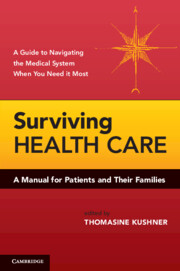Book contents
- Frontmatter
- Contents
- Contributors
- Preface
- 1 Letter to Patients
- 2 Becoming an Active Member of Your Health Care Team
- 3 Information That Will Help You with Advance Planning for Your Health Care
- 4 Responding to Medical Emergencies
- 5 What You Need to Know about Medical Errors
- 6 Being Informed When You Give Consent to Medical Care
- 7 Beware of Scorecards
- 8 Transplantation 101
- 9 When the Illness Is Psychiatric
- 10 On the Horizon
- 11 To Be or Not to Be – A Research Subject
- 12 Information That Will Help You Make Health Care Decisions for Adult Family Members
- 13 Caring for Individuals with Alzheimer's Disease
- 14 When the Patient Is a Child
- 15 Care of Elders
- 16 Being and Thinking
- 17 A Patient's Guide to Pain Management
- 18 The Hardest Decisions
- 19 What You Need to Know about Disasters
- 20 Making the Internet Work for You
- Appendix: Patient Individual Profile
- Index
11 - To Be or Not to Be – A Research Subject
Published online by Cambridge University Press: 05 June 2012
- Frontmatter
- Contents
- Contributors
- Preface
- 1 Letter to Patients
- 2 Becoming an Active Member of Your Health Care Team
- 3 Information That Will Help You with Advance Planning for Your Health Care
- 4 Responding to Medical Emergencies
- 5 What You Need to Know about Medical Errors
- 6 Being Informed When You Give Consent to Medical Care
- 7 Beware of Scorecards
- 8 Transplantation 101
- 9 When the Illness Is Psychiatric
- 10 On the Horizon
- 11 To Be or Not to Be – A Research Subject
- 12 Information That Will Help You Make Health Care Decisions for Adult Family Members
- 13 Caring for Individuals with Alzheimer's Disease
- 14 When the Patient Is a Child
- 15 Care of Elders
- 16 Being and Thinking
- 17 A Patient's Guide to Pain Management
- 18 The Hardest Decisions
- 19 What You Need to Know about Disasters
- 20 Making the Internet Work for You
- Appendix: Patient Individual Profile
- Index
Summary
For most people, the terms clinical trial, institutional review board, risk–benefit assessment, and informed consent make as much sense as the instruction manual for a complicated piece of technology. Indeed, most people probably do not know that when medical research is conducted to test a new medicine, there are rules and procedures the scientists must follow to ensure that the research is both scientifically sound and ethically safe. Most people do not know there are different kinds of medical studies; some are conducted on people who already have a disease or medical condition, and others are performed on healthy volunteers who want to help science find answers. Yet both types of potential research subjects have many of the same questions, the answers to which can help them decide whether to participate in the study, what their rights are, and what decisions they may have to make. This chapter reviews the basics of being a research subject – including the potential benefits and risks of making this important decision.
The Basics
Once you become a patient, it won't be long before somebody asks you to be a research subject. For example, your doctor might want to enroll you in a clinical trial of a new medication, possibly for a condition for which other drugs are available – such as high blood pressure – or for one for which there are no approved treatments yet.
Keywords
- Type
- Chapter
- Information
- Surviving Health CareA Manual for Patients and Their Families, pp. 146 - 162Publisher: Cambridge University PressPrint publication year: 2010



